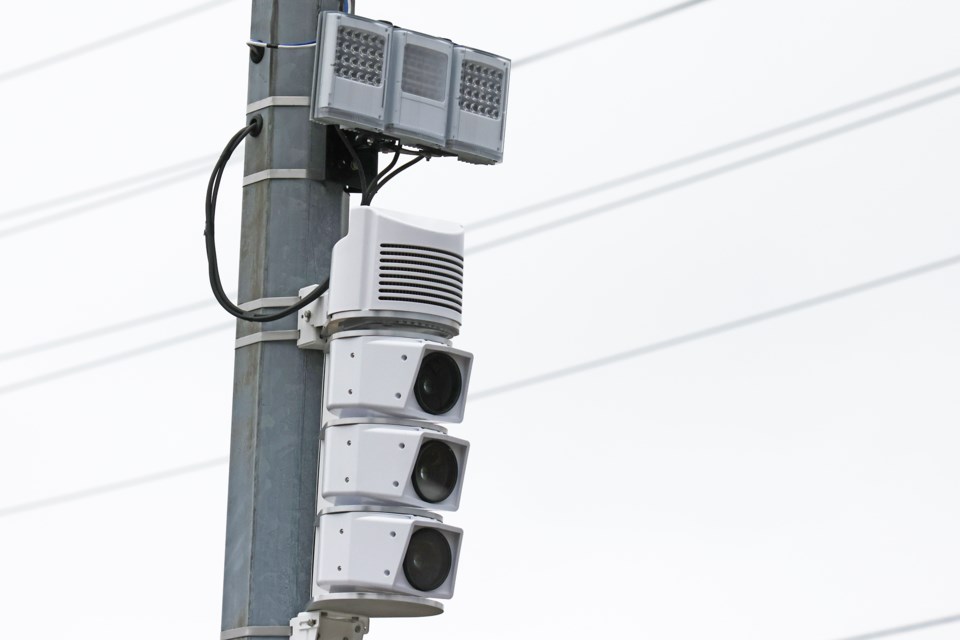City councillors are struggling with the triggers to hire additional staff to process the increasing volume of speed-camera tickets issued in Barrie.
Sitting as general committee Tuesday night, councillors gave initial approval to an administrative penalty system, which costs the city $17 to process a ticket compared to $55 in the traditional court system, for the automated speed enforcement (ASE) cameras program.
More than 9,200 ASE tickets were processed for the initial three months of Barrie’s speed cameras program, which began Dec. 1.
Rodger Bates, the city’s manager of court services, said that number had climbed to 13,000 by the end of March.
“We launched this program with the expectation of less than 1,000 charges per month,” he said. “The first day there was, with two cameras, over 1,600 potential violations. There are lots of violators … to my surprise, it was shocking.”
As part of approving the administrative penalty system, councillors also gave initial approval to a motion that the city would hire two screening officers/junior prosecutors, funded by additional ASE revenue, with further authorization to hire one officer per additional 40,000 speed violations issued in Barrie, along with hearing officer services for as much as $50,000, again funded by additional ASE revenue.
“This would almost be achieving staffing at no cost, as it would be paid for by the violations,” said Deputy Mayor Robert Thomson.
But there were concerns about such hirings being taken out of council’s hands.
“It’s basically a carte blanche to continue to hire people without ever coming back to council,” said Coun. Gary Harvey, “and I don’t know of any other position in this organization (City of Barrie) that we’ve given that type of delegated authority for. They’ve always had to come back whether it’s budget time or if it’s something urgent through the year to request funding to hire an additional person.
“There obviously is a certain ratio of … (speeding) offence notices that are going to come back, with the amount of people that want to potentially fight them, but to just say that every 40,000 violations that we need another body I think is a little over-stepping.”
Harvey introduced an amendment to the motion to remove the 40,000 trigger, but later withdrew it.
Bates said the 40,000 number is based on limited data, as the ASE program has only been running since early December.
Mayor Alex Nuttall asked for more information ahead of city council considering final approval of the administrative penalty system at its May 1 meeting.
“There’s a lot of talk around this (city council) table about making decisions based on data that we don’t have,” he said. “We do not have that data yet. We have an estimate, we have a guesstimate. What I’m not willing to do is just to say we’re going to set a policy for the city based on an estimate or guesstimate.
“But my mind can be changed between now and next week (May 1), with some great data to back it up.”
Councillors were also told there would be a staff memo to council to go along with any proposed hirings.
“We’re only asking for additional staffing without coming back, if in fact the numbers are there,” Bates said. “I can only see this program expanding in Barrie and we wouldn’t just be arbitrarily hiring people if we didn’t need them.”
Approval of the administrative penalty system also includes renovating the city’s Cedar Pointe Drive offices, costing $100,000, for the screening and hearing officers required for the program. This would be funded from the city’s tax capital reserve, but eventually offset by revenue from the ASE program.
Every 40,000 violations issued would cost the city $680,000 to process in the administrative penalty program, while it would cost $2.2 million in a traditional court, resulting in approximately $1.52 million in savings for the city.
“This (ASE) program is a fantastic success for the City of Barrie by any independent criteria you look at — cost efficiencies, lowering of speeding, holding people accountable for the actions they are taking and relieving the burden for the taxpayer,” said Michael Prowse, the city’s chief administrative officer.
The majority of councillors supported the administrative penalty system motion that was presented Tuesday night.
“I really don’t think we need to micromanage this,” said Coun. Clare Riepma. “The volume (of speeding tickets) is going to actually have to be there before we proceed with (hiring) another person.”
“Hopefully what we’re doing is changing (driving) behaviour so won’t see continued escalation of (speeding ticket) numbers over time,” said Coun. Jim Harris.
ASE is a system that uses a camera and a speed-measuring device to detect and capture images of the licence plates of vehicles travelling faster than the posted speed limit in school or community safety zones.
Barrie’s ASE cameras were initially located eastbound on Big Bay Point Road, near Willow Landing and St. Michael the Archangel Catholic elementary schools, and southbound on Anne Street North, near Portage View and Nouvelle-Alliance schools, last Dec. 1.
The ASE cameras were moved to northbound Essa Road near Timothy Christian School, and westbound on Ardagh Road in the vicinity of Heritage Baptist Church, near the end of February.
ASE cameras nailed 9,240 vehicles for speeding at the first two Barrie locations, with an average ticket fine of $90, from Dec. 1, 2023 until Feb. 18, 2024, according to a city memo. It also says 4,563 speeding tickets were issued on Big Bay Point Road and 4,677 on Anne Street North.
The same city memo also says cameras in the first two locations were successful in significantly reduced speeding there, when compared to the use of flashing 40-km/h lights. During peak school hours speeds were reduced by 12 km/h at the Big Bay Point Road location and 13 km/h at the Anne Street location. This reduction is compared to speeds during peak school hours when the flashing 40 km/h lights were in use.



